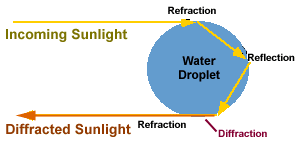 |
| An image of a "glory" on layer of cloud. Photo courtesy Northern Ireland Amateur Astronomers Society |
On a rainy October 7, I began my first trip to the East Coast since my mother died in early June. I was looking forward to the trip to see my father and extended family, but knew this visit would be hard. I had been flying across the country to visit my parents for a decade, ever since I moved West. In the past few years, as my own children have become more independent, I've been making the long trip more frequently and alone.
I had developed a good system: public transport to the airport, one carry-on roller bag, one book for pleasure reading, several books on clouds, a camera, and a window seat to watch the skies. The journey took all day, but ended at the home where I grew up, where my parents had lived for nearly forty years. My father would pick me up at the airport, my mother would come out on the porch to greet me. Depending on the time of day, we'd have hot tea or a glass of wine and spend the next few hours catching up. It was not until my plane took off and we rose steadily through the layer of clouds over Seattle that reality hit. My mother was not going to be there.
My face pressed to the window, looking down on the sea of lumpy gray clouds, I began to cry. And then I turned my shoulders toward the window so my seat mates wouldn't hear me snuffling. My mother took great pleasure in my interest in clouds and had sent me several books, post cards, and photographs from the newspaper of clouds over the past few years. She had a special fondness for the high cirrus clouds that reminded her of angels. Though she didn't like to fly, I know she would have enjoyed the view at 30,000 feet.
As we crossed the Cascades, the nimbostratus and stratocumulus clouds thinned and I got peeks at plots of farmland and stretches of the Columbia River. The clouds looked more like altocumulus now but were still thick, still blanketed much of the landscape below.
I couldn't help but stare. Perhaps because I was staring, crying, scrunched up in the window almost looking straight down below the plane, I saw something I had never seen before: It was the tiny, perfectly formed shadow of our airplane cast on the layer of cloud below. Encircling the entire shadow was a rainbow. Only I knew it wasn't a rainbow.
Through my tears, I watched the shadow and the concentric circles of colored light for several minutes. It was beautiful, even comforting. When the clouds thinned over the Columbia Plateau, the whole thing vanished and I reached into my bag for one of my cloud books.
 |
| Never leave home without it. |
Around 11:30 a.m., when I saw the glory, I was sitting on the left side of the plane (facing north) and the sun was high and shining from the right side of the plane (the south). As the wavelengths of sunlight entered the small water droplets in the cloud, they slowed, and were refracted (bent) along the edge of each droplet. When that light hits the back of the droplet, it is reflected to the other side of the droplet where it refracted again before leaving the droplet. Had this been all that was going on in these droplets, the sunlight would have separated into the ROY G. BIV colors and I would have seen a rainbow. But I did not see a rainbow. That's because the wavelengths of light actually cling ever so slightly to the edge of the droplet. This clingy type of bending is called diffraction--a bending of light as it passes around the droplet.
 |
Graphic courtesy the University of Illinois WW2010 Project |
Thanks to refraction, reflection, and diffraction, the sunlight was doing 180-degree turns inside the water droplets. Sunlight that does 180s inside a water droplet creates faintly colored rings of light--a variation on the rainbow theme. That light--the glory--can also form around the shadow of a person's head if he or she is standing above a bank of clouds or fog, back to the sun. The circles of light then appear like a halo, hence the name "glory."
I learned all of this science later, after I returned home from a wonderful visit with my father. But while I was there, I remained happily ignorant of all of this, wanting to hold in my heart the image of our tiny plane--a shadow floating on the clouds and embraced by an ethereal light of a distant star.


